Many pet bird owners don’t keep cockatiel wings clipped because they feel it will hurt the bird, they don’t know how, they think the bird is prettier with full feathers, or they feel it isn’t fair to the bird. I believe it isn’t fair to let a pet bird go unclipped.I clip wings of all my pet birds and those I sell as pets, for their safety. Can you imagine the heartbreak you would feel if your pet cockatiel flew into the ceiling fan, a tub full of hot water, or worse yet, out an open door or window never to be seen again? Remember, your bird is domestic and is not accustomed to having to find it’s own food or fight off larger animals.
You can easily clip your cockatiels wings without the aid of others. Clipping wings will reduce your bird’s ability to fly. This in turn can make the taming process easier. With your bird’s wings properly clipped, it won’t be as apt to fly out an open door or window accidentally. Many pet birds have been lost forever due to being fully flighted. Even clipped wings won’t guarantee your pet bird won’t be able to fly. With a slight breeze, even a clipped bird has the ability to gain altitude.
When done properly, clipping wing feathers will not hurt your bird. Be sure to clip both wings. Clipping only one can cause the bird harm due to the bird’s inability to navigate from the uneven weight distribution. A lot of birds have been injured due to only one wing being clipped when they navigated themselves into a wall or window.
If you’re a beginner, either have another person help you or have your cockatiel’s wings clipped by an experienced person the first time. You can observe how it is done and do it yourself the next time.
I use the method I’ll describe here. When I’m clipping smaller birds wings, I generally do it sitting down. I then place the birds body between my legs. I stretch one wing at a time across my leg and clip the feathers in the manner described below. I’ve found this to be much less traumatic to the birds and it doesn’t cause the bird to have an unnecessary fear of towels. I may need them to think of the towel as their friend at a later date when needing to restrain them in a more firm way.
If you are a beginner, you may find it easier to have a friend assist you, one of you will need to restrain the bird while the other does the clipping. Have a pair of sharp scissors, some sort of blood clotting agent (just in case you should injure the bird by accident) and a towel ready. You shouldn’t need the clotting agent but it’s better to be safe than sorry anytime you are working on a bird using sharp objects. The towel is only necessary if your bird should try to bite. In this case the towel would be loosely draped over the head of the bird. Be careful not to smother the bird. Remember, clipping the wings isn’t hurting the bird, he’s only mad at being restrained or afraid.

Generally wings are clipped in one of two ways. I use Version One (below).

The first time your bird has it’s wings clipped, it doesn’t know it can no longer fly. The bird will try, but will fall to the floor. The best way to assist a bird in learning it no longer has the ability to fly is to do this in a carpeted room. This will make the birds first few landings a lot softer and more safe . Make sure you are working with it close to floor level so the bird doesn’t injure itself by falling into objects or onto the floor doing damage to the skin over it’s breast bone (keel). Your cockatiel will quickly adjust to it’s inability to fly.
Version Two (below), is used when appearance is your main concern I don’t recommend this clip

It’s not a problem to pull broken feathers out as long as this is done with great care. Using a pair of needle nose pliers, get a firm grasp of the feather as close to the skin as you can. It helps to hold the wings close to where the feather shaft enters the wing, and give it a quick jerk. Hold the area where the feather was removed with firm pressure for a few minutes to assist in stopping any possible bleeding. You can use this same procedure for removal of broken tail feathers also.
Watch your bird closely for feather re-growth. I’ve seen them grow out in just a matter of a few weeks. They won’t grow at the same rate but will grow out one or two at a time. As feathers grow out a bit, it’s easy to trim them in the same manner as you did originally.
Please, if you are uncomfortable clipping wings, it is best to watch a vet or pet store employee clip them the first time. You can always do it from that point on if you so choose.

